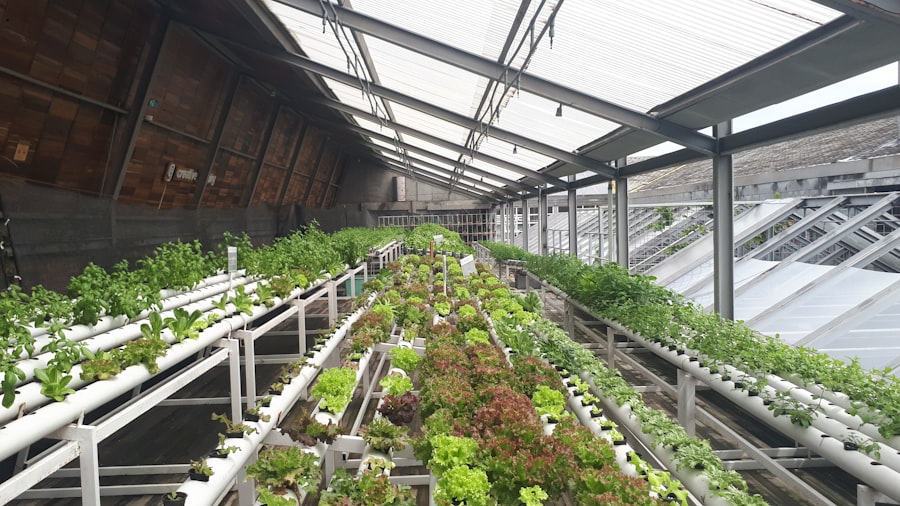Vertical farming has emerged as a revolutionary approach to agriculture, addressing the pressing challenges of urbanization, food security, and environmental sustainability. As the global population continues to swell, projected to reach nearly 10 billion by 2050, the demand for food is escalating at an unprecedented rate. Traditional farming methods, reliant on vast tracts of arable land and susceptible to climate variability, are increasingly inadequate to meet this demand.
In response, vertical farming has gained traction as a viable solution, utilizing innovative techniques to grow crops in stacked layers or vertically inclined surfaces, often within controlled indoor environments. The concept of vertical farming is not entirely new; it has roots in ancient practices such as the Hanging Gardens of Babylon. However, the modern iteration leverages advanced technologies such as hydroponics, aeroponics, and aquaponics, which allow for soil-less cultivation.
These methods not only maximize space but also minimize water usage and reduce the need for pesticides. The rise of vertical farming is also fueled by urbanization trends, with more than half of the world’s population now residing in cities. Urban vertical farms can provide fresh produce directly to city dwellers, reducing transportation costs and carbon footprints associated with traditional agricultural supply chains.
Key Takeaways
- Vertical farming has seen a significant rise in popularity due to its ability to produce high yields in small spaces and reduce the environmental impact of traditional agriculture.
- Automation plays a crucial role in vertical farming, allowing for precise control of environmental conditions, nutrient delivery, and harvesting processes.
- Advantages of automation in vertical farms include increased efficiency, reduced labor costs, and the ability to monitor and adjust growing conditions in real time.
- Challenges and limitations of automation in vertical farming include high initial investment costs, technical complexity, and the need for skilled personnel to operate and maintain automated systems.
- Innovations in automation technology for vertical farms include the development of advanced sensors, robotics, and AI systems to further optimize and streamline the growing process.
Automation in Vertical Farming
Automation is a cornerstone of modern vertical farming, enabling the efficient management of complex systems that would be challenging to operate manually. The integration of robotics, artificial intelligence (AI), and Internet of Things (IoT) technologies has transformed how crops are cultivated, monitored, and harvested. Automated systems can regulate environmental conditions such as temperature, humidity, and light levels, ensuring optimal growth conditions for various crops.
This level of precision is particularly crucial in vertical farms where space is limited and every square foot must be utilized effectively. Robotic systems are increasingly employed for tasks such as planting seeds, monitoring plant health, and harvesting crops. For instance, autonomous drones equipped with cameras and sensors can assess plant growth and detect diseases or pests early on.
This real-time data collection allows farmers to make informed decisions about crop management and resource allocation. Additionally, automated nutrient delivery systems can precisely dispense water and fertilizers based on the specific needs of each plant variety, further enhancing efficiency and reducing waste.
Advantages of Automation in Vertical Farms

The advantages of automation in vertical farming are manifold, significantly enhancing productivity and sustainability.
By automating routine tasks such as planting, watering, and harvesting, farms can operate with fewer human resources while maintaining high levels of output.
This is particularly advantageous in regions where labor shortages are prevalent or where labor costs are rising. Moreover, automation contributes to improved crop yields and quality. Automated systems can monitor environmental conditions continuously and adjust them in real-time to optimize growth.
For example, LED lighting systems can be programmed to provide specific light spectrums that promote photosynthesis at different growth stages. This level of control not only accelerates growth cycles but also enhances the nutritional value and flavor profile of the produce. Furthermore, automated monitoring systems can detect anomalies in plant health early on, allowing for timely interventions that prevent crop loss.
Challenges and Limitations of Automation in Vertical Farming
Despite its numerous advantages, the automation of vertical farming is not without challenges and limitations. One significant hurdle is the high initial investment required for advanced automation technologies. The cost of robotics, sensors, and AI systems can be prohibitive for small-scale farmers or startups looking to enter the vertical farming market.
This financial barrier may limit the widespread adoption of automation technologies across the industry.
Automated systems can be susceptible to malfunctions or cyberattacks, which could disrupt operations and lead to significant losses.
For instance, if a critical sensor fails to monitor humidity levels accurately, it could result in crop damage or loss. Furthermore, while automation can enhance efficiency, it may also lead to a reduction in job opportunities within the agricultural sector, raising ethical questions about the future of work in this field.
Innovations in Automation Technology for Vertical Farms
The landscape of automation technology in vertical farming is rapidly evolving, with continuous innovations aimed at enhancing efficiency and productivity. One notable advancement is the development of autonomous vehicles designed specifically for indoor farming environments. These vehicles can navigate through narrow aisles between stacked crops, performing tasks such as planting seeds or transporting harvested produce without human intervention.
Another exciting innovation is the use of machine learning algorithms to analyze data collected from various sensors throughout the farm. These algorithms can identify patterns and correlations that may not be immediately apparent to human operators. For example, by analyzing historical data on crop performance under different environmental conditions, machine learning models can predict optimal growing conditions for future crops.
This predictive capability allows farmers to make data-driven decisions that enhance yield and reduce resource consumption.
The Impact of Automation on Vertical Farming Industry

The impact of automation on the vertical farming industry is profound and multifaceted. As automated systems become more prevalent, they are reshaping operational practices and business models within the sector. For instance, large-scale vertical farms equipped with advanced automation technologies can achieve economies of scale that were previously unattainable in traditional agriculture.
This shift not only increases production capacity but also drives down costs for consumers. Moreover, automation is facilitating the emergence of new business models centered around subscription services and direct-to-consumer sales. With automated systems enabling consistent year-round production of high-quality crops, vertical farms can offer fresh produce directly to consumers through online platforms or local delivery services.
This direct connection between producers and consumers fosters transparency in food sourcing and enhances consumer trust in the quality of their food.
The Future of Vertical Farms: Fully Automated Systems
Looking ahead, the future of vertical farming appears increasingly aligned with fully automated systems that leverage cutting-edge technologies to optimize every aspect of production. The vision of fully automated vertical farms includes not only advanced robotics for planting and harvesting but also sophisticated AI-driven management systems capable of making real-time decisions based on a multitude of variables. These fully automated farms could operate with minimal human intervention, relying on a network of interconnected devices that communicate seamlessly with one another.
For example, an AI system could analyze data from weather forecasts, market demand trends, and crop health metrics to determine the optimal time for planting or harvesting specific crops. Such a level of integration would not only enhance efficiency but also enable farmers to respond swiftly to changing market conditions or environmental challenges.
Sustainability and Efficiency in Automated Vertical Farms
Sustainability is a core tenet of vertical farming, and automation plays a crucial role in enhancing both sustainability and efficiency within these systems. Automated vertical farms utilize significantly less water compared to traditional agriculture due to their closed-loop irrigation systems that recycle water efficiently. This conservation is particularly vital in regions facing water scarcity.
Furthermore, automated systems can minimize energy consumption through smart lighting solutions that adjust based on real-time plant needs. For instance, LED lights can be programmed to provide varying light intensities throughout the day, mimicking natural sunlight patterns while reducing energy costs. Additionally, by locating vertical farms closer to urban centers, transportation emissions associated with food distribution can be drastically reduced.
In conclusion, as vertical farming continues to evolve through automation and technological advancements, it holds immense potential for transforming agriculture into a more sustainable and efficient industry capable of meeting the demands of a growing global population while minimizing its environmental impact.
If you are interested in exploring innovative technology like automation in agriculture, you may also want to check out the article Unlock Your Creative Potential with the Samsung Galaxy Book Flex2 Alpha. This article discusses how the latest Samsung device can enhance your creativity and productivity, showcasing the intersection of technology and creativity in our daily lives.
FAQs
What is a vertical farm?
A vertical farm is a type of indoor farm that utilizes vertical space to grow crops in stacked layers, often in a controlled environment.
What is automation in vertical farming?
Automation in vertical farming involves the use of technology and robotics to perform tasks such as planting, watering, harvesting, and monitoring environmental conditions without the need for human intervention.
How does automation benefit vertical farms?
Automation in vertical farms can increase efficiency, reduce labor costs, optimize resource usage, and improve crop yields by providing precise control over growing conditions.
What are some examples of automation technologies used in vertical farms?
Examples of automation technologies used in vertical farms include robotic arms for planting and harvesting, sensors for monitoring and adjusting environmental conditions, and automated systems for nutrient delivery and irrigation.
What is the future outlook for vertical farms powered by automation?
The future of vertical farms powered by automation is promising, with advancements in technology expected to further improve efficiency, sustainability, and scalability of vertical farming operations.

